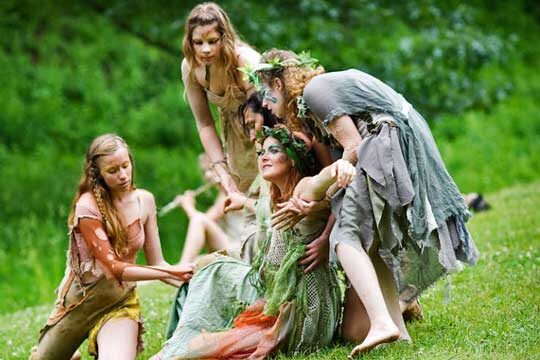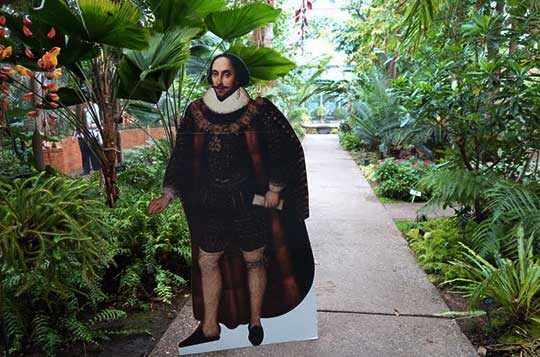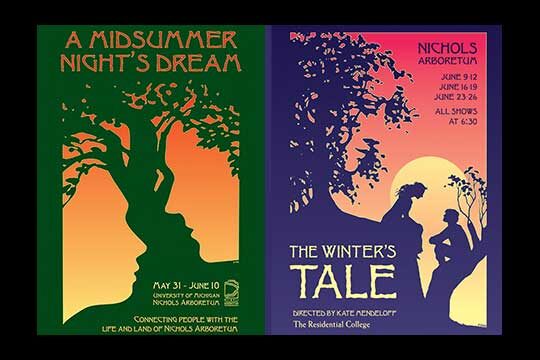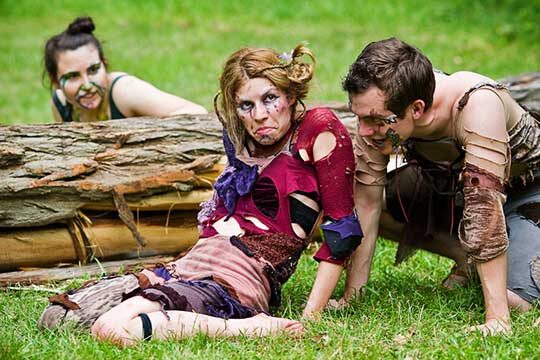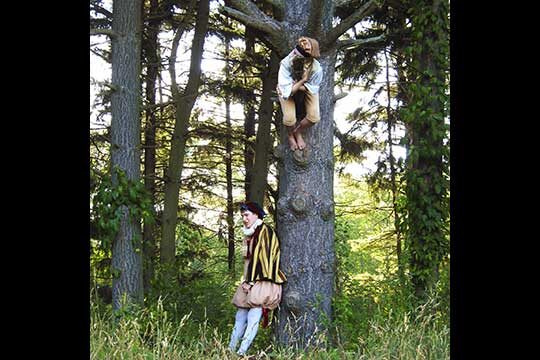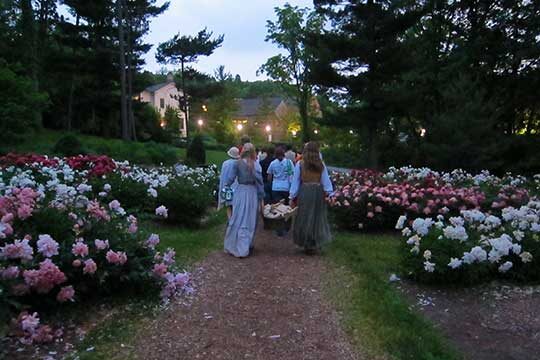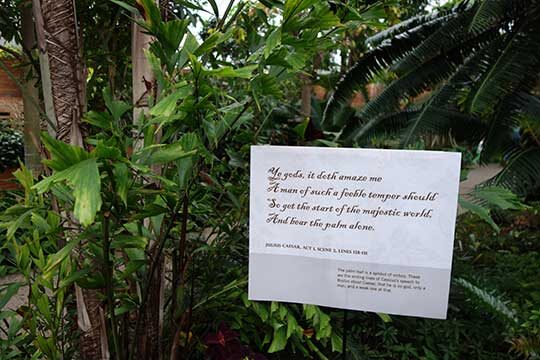All the Arb’s a stage
For 15 years director Kate Mendeloff has been delighting Shakespeare fans amid the flora and fauna of the Nichols Arborteum at U-M. This year Shakespeare lovers can stroll through Shakespeare’s Garden in the Matthaei Botanical Gardens’ conservatory. This tribute to the Bard’s affinity for nature runs through May 4 and promotes Shakespeare in the Arb, which bows June 4. (Photos provided by Matthaei Botanical Gardens and Nichols Arboretum, unless otherwise noted.)
-
15 years and counting
Shakespeare in the Arb debuted in 2001 under the direction of U-M’s Kate Mendeloff, a lecturer in drama in the Residential College. “I wanted the audience to feel transformed by their experience of the Arb so I decided that our first performance would be ‘A Midsummer Night’s Dream,’” Mendeloff says. “Hermia and Lysander, Helena and Demetrius, Peter Quince and his mechanicals, even those at home in the fairy world, are all changed by their journey into the forest.”
Image: Eva Rosenwald as Titania, Sian Dowis as Peaseblossom, Megan Mertaugh as Cobweb, Elise Randall as Mustardseed, and Alison Clinton as Moth in “A Midsummer Night’s Dream,” 2010. (Photo by Myra Klarman.)
-
Take a bow
Kate Mendeloff has directed nine different Shakespeare plays since 2001, including “Much Ado About Nothing,” “The Winter’s Tale,” “The Merry Wives of Windsor,” and “The Tempest.” With each production she embraces the artistic challenge and unique opportunity to make the Arb its own featured character. (Photo by Michelle Yanga.)
-
Shakespeare’s Garden
From his early days until his death, Shakespeare embraced and absorbed the plant culture thriving around him in his native Stratford-upon-Avon in England. The language of his plays and poems is filled with allusions to plants and their intricate layers of meaning. His nature imagery, along with the 15th anniversary of Shakespeare in the Arb, inspired the Shakespeare’s Garden exhibit at the Matthaei Botanical Gardens through May 4. (Photo by Sydney Hawkins.)
-
Magic and illusion
U-M alumnus and renowned artist David Zinn has created the iconic images on each of the Shakespeare in the Arb promotional posters since its debut. The posters have become as well known as the productions themselves; the artist playfully hides silhouettes and faces within the foliage. Zinn’s posters are on view as part of the Shakespeare’s Garden exhibit at the Matthaei Botanical Gardens through May 4.
-
Accidents will happen
The outdoor setting can be capricious, to say the least. During Shakespeare in the Arb’s opening weekend in 2001, temperatures hovered around 45 degrees with the added insult of cold rain. Many of the actors enjoy the “unpredictable” aspects of the outdoor setting: A butterfly may float through a scene at just the right moment, a deer may lope by, and hawks have been known to bicker overhead.
Image: The tripartite Puck in the 2010 production of “A Midsummer Night’s Dream.” From left: Mandy Bannatz, Jaclyn Dudek, and Greg Kovas. (Photo by Myra Klarman.)
-
Location, location, location
The plays are usually built around contours of the Arb and its natural features. There is no fixed stage. Instead, the audience follows the action from location to location. In this way, the Arb itself becomes a major player showing off its vistas, valleys, and hidden wonders.
Image: Master Slender (Harrison Lott) wallows in despair while his servant, Simple (Brittany Battle), sleeps on a tree branch in the 2012 production of “The Merry Wives of Windsor.” (Photo by Michele Yanga.)
-
Action!
Scenes are staged primarily in places that can function as a natural amphitheater — in bowls, between hills, or in front of trees. The lack of traditional acoustics requires a natural setting that amplifies sound — and actors who can project.
Image: Jose Fernandez Garcia as Don Armado threatens Chris Harrison as Costard in “Love’s Labour’s Lost” while Jaclyn Dudek as Moth, looks on (2006).
-
Dressed for success
Without a stage or fixed sets, the costumes must do most of the work to transport the audience back in time. Roberta VanderMey worked as lead costume designer for the first seven years of production, and though she passed away in 2011, her legacy lives on through the many costumes she created for Shakespeare in the Arb. Some of the pieces she designed for the 2001 debut of “A Midsummer Night’s Dream” are still worn today. Select costumes are on display as part of the Shakespeare’s Garden exhibit at the Matthaei Botanical Gardens through May 4.
Image: Carol Gray as Sylvia (left) and Jose Fernandez Garcia as Sir Thurio (right) in “The Two Gentlemen of Verona” in 2008.
-
A peony by any other name…
Shakespeare in the Arb performances coincide with the annual peak bloom in the peony garden at Nichols Arboretum. The bloom typically runs from Memorial Day (late May) to the summer solstice (mid-June). This garden boasts one of the oldest and largest collections of heirloom herbaceous peonies; it contains more than 270 historic cultivated varieties.
Image: Actors walk through the peonies to the Reader Center at the conclusion of “The Winter’s Tale” in 2011.
-
Kings and peasants
Many actors have returned to the Arb over the years, including Martin Walsh (center) who has appeared in almost every performance since opening day in 2001. Walsh is a lecturer in U-M’s Residential College and head of its drama program. Here, he is pictured as John Falstaff with Jeanne Leverich (left) as Mistress Page and Maria Thomas as Mistress Ford (right) in the 2012 production of “The Merry Wives of Windsor.”
-
A community affair
“A Midsummer Night’s Dream” has become an audience favorite over the years. In many ways it is an ideal fit for the Arb, says director Kate Mendeloff. For the production’s 15th anniversary in June, she will reprise the play for a fifth time. Her cast will include U-M students, faculty, staff, and alumni, as well as Ann Arbor community members. There are even roles for the youngest of fairies, as in this photo from the 2010 production.
-
Notable quotable
Matthaei’s conservatory features many of the plants referenced in the Bard’s poems and plays. For example, the palm leaf is a symbol of victory. This placard among Matthaei’s palms features an excerpt from the play “Julius Caesar,” which includes the closing lines of Cassius’ speech to Brutus. Cassius makes it clear that Caesar is only a man, and a weak one at that.
Ye gods, it doth amaze me
A man of such a feeble temper should
So get the start of the majestic world,
And bear the palm alone.
(Photo by Sydney Hawkins.)

